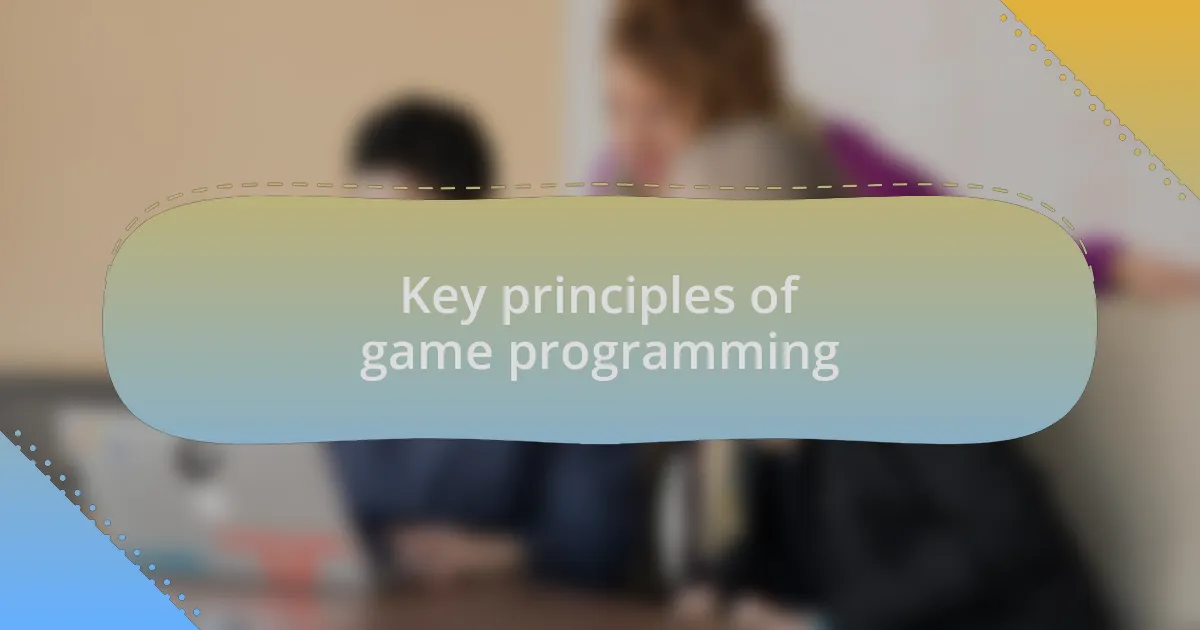Key takeaways:
- Scalability in games is crucial for handling user growth, content updates, and maintaining performance across devices.
- Effective game design considers modular architecture, resource management, and seamless player experiences to enhance engagement and retention.
- Utilizing tools for performance measurement, such as Unity Profiler, and leveraging player data analytics can inform improvements and optimize gameplay.
- Successful games like “Fortnite,” “Minecraft,” and “League of Legends” highlight the importance of adaptability and community engagement in achieving long-term scalability.

Understanding scalability in games
Scalability in games is all about how well a game can adapt to increasing demands, whether that’s handling more players, adding more content, or optimizing performance across various devices. I remember the first time I encountered severe lag during a multiplayer session; it was frustrating to witness the game world slow down while my friends and I were battling it out. What happens to the gaming experience when a server can’t keep up with the influx of players? That’s where discussing scalability becomes critical.
Consider how crucial it is for a game to scale seamlessly. When I developed a small indie game, I faced challenges as the player base grew unexpectedly. It was an eye-opener to realize that a game built for a few dozen players could quickly falter when hundreds logged on simultaneously. Have you ever thought about how these issues affect player retention? A smooth experience means players are more likely to stay engaged.
Ultimately, understanding scalability isn’t just a technical requirement; it’s a design philosophy. I often ask myself, what kind of experience do I want to create? Having that clear vision allows for smarter decisions regarding architecture and infrastructure. Balancing performance and creativity should always be at the forefront of a developer’s mind, ensuring the game can evolve without sacrificing quality.

Importance of scalable game design
The importance of scalable game design cannot be overstated. I vividly recall the moment my team’s game launch veered off course due to unexpected server overload. Just imagine the disappointment of eager players being met with crashes and lag; it felt like throwing a party and no one could get in. This experience reinforced my belief that a game must accommodate unpredictable growth, ensuring all players can enjoy it without frustration.
When designing a scalable game, I often consider how different elements can impact the overall experience. During one project, I implemented modular level designs, which not only streamlined content creation but also allowed us to adapt to user feedback effectively. Have you ever played a game that felt too constrained? By prioritizing scalability, we can create dynamic and flexible gameplay that closely aligns with audience expectations while enhancing replayability.
Thinking about scalability goes beyond mere performance; it influences community and longevity. A game with room to expand can foster a thriving ecosystem where players feel invested in an evolving world. I’ve seen firsthand how engaging with a community of passionate players can lead to content that extends a game’s life. How do you see scalability shaping the gaming landscape in the future? For me, it’s about crafting experiences that resonate and adapt, promoting relationships that last long after the initial excitement fades.

Key principles of game programming
When I think about the key principles of game programming, the first thing that comes to mind is the importance of solid architecture. I once worked on a game where poor coding practices led to a tangled mess, making it incredibly difficult to implement any changes. Have you ever tried fixing a leaky faucet, only to find a whole plumbing system that’s outdated? That’s what bad architecture feels like in game development.
Another vital principle is maintaining code modularity. During a project where I focused on breaking down larger systems into smaller, manageable components, I was amazed at how this clarity improved both our team’s workflow and the game’s performance. It’s like building with LEGO blocks—when each piece fits perfectly, the entire structure stands tall and strong. I believe this not only enhances development speed but also allows for easier debugging and future expansions.
Lastly, optimally managing resources is crucial. I remember a time when we ran into frame rate issues because assets weren’t efficiently handled. It taught me that the balance of visual fidelity and performance can make or break the player experience. Don’t you want players to immerse themselves without constant slowdowns? Keeping an eye on resource management ensures that players enjoy a seamless journey, enhancing their overall connection to the game.

Techniques for efficient coding
Efficient coding starts with writing clean, readable code. I remember a project where I spent hours deciphering my own convoluted code just to implement a simple feature. It was frustrating! I realized then that using meaningful variable names and consistent formatting could have saved me time and headaches. It’s like reading a good book—clear language pulls you in, while a disorganized narrative just turns you away.
Another technique is leveraging version control systems like Git. During my early days, I faced a nightmare when I accidentally lost a week’s worth of work due to a failed merge. These tools not only help in tracking changes but also foster collaboration, enabling everyone on the team to contribute without stepping on each other’s toes. Imagine cooking together while keeping track of each ingredient’s source; that’s the kind of harmony version control offers in coding.
Lastly, I find that implementing comments judiciously can simplify teamwork tremendously. In a recent project, I made a habit of leaving comments explaining complex logic. It turned out to be a game-changer when a new team member joined. They ramped up quickly, and it felt rewarding to see them thriving without me needing to hold their hand. Why make things harder for your future self and teammates when you can lay down a roadmap?

Tools for measuring performance
When it comes to measuring performance in games, tools like Unity Profiler and Unreal Engine’s built-in profiling tools are indispensable. I remember the first time I ran the Unity Profiler on a project; it was enlightening to see the frame rates dip at certain levels. That visibility helped me optimize the graphics and scripts, leading to a smoother player experience. Are you using the right tools to keep your game running smoothly?
Moreover, metrics tracking services like GameAnalytics and Firebase offer valuable insights into player behavior. I once integrated GameAnalytics into a mobile game and discovered that players were dropping off at a specific level. This feedback was crucial! It prompted me to tweak the level design, enhancing retention significantly. Isn’t it amazing how data can shine a light on what’s really happening behind the scenes?
Another effective method is using platform-specific tools, such as the PS4 Performance Analyzer or Xbox Development Kit. I had the opportunity to work on a console game where the Xbox tools revealed unexpected memory leaks. It was a challenge, but overcoming it not only improved performance but also taught me the importance of platform-specific optimizations. How well do you know your platform’s strengths and weaknesses?

My personal scalability strategies
While scaling a game, I prioritize modular design—creating separate systems that can function independently yet collaboratively. This approach was particularly effective when I developed a multiplayer game; by decoupling the server and client functionalities, I could iterate and enhance each component without impacting the other. Have you considered how modularity could benefit your projects?
Another strategy I utilize is efficient asset management. In one project, I faced massive loading times due to unoptimized textures. By implementing texture atlases, I not only reduced load times but also improved the overall performance of the game. It’s fascinating how small changes can lead to significant improvements—have you explored optimizing your assets?
Lastly, I always plan for cloud scalability when building online features. During a game launch, I experienced unexpected traffic that could have led to server crashes. Thankfully, my cloud infrastructure allowed me to scale quickly and handle the influx without any downtime. It’s reassuring to know that you can prepare for the unpredictable, isn’t it?

Case studies of successful games
When I think about scalability in successful games, I can’t help but reference the evolution of “Fortnite.” Epic Games transformed what started as a cooperative survival game into a global phenomenon with a battle royale mode, demonstrating how adapting to player feedback and trends can embrace scalability. I remember watching how their ability to introduce new content constantly kept players engaged. Have you thought about how flexibility in game design might keep your player base thriving?
Another great example is “Minecraft,” which showcases scalability through its simple yet profound block-building mechanics. The game’s architecture allows for endless expansions, both in terms of player creativity and downloadable content. I recall the buzz when a new update dropped—players flocked back to explore new features. How often do you consider the potential for your game to evolve with its community?
“League of Legends” also stands out with its iterative approach to balancing and introducing new champions. Riot Games has mastered the art of scalability by constantly evolving gameplay based on player behavior and competitive dynamics. I find it remarkable how their regular updates foster a sense of involvement among players. Do you see the benefits of making your game a living entity that grows alongside its audience?